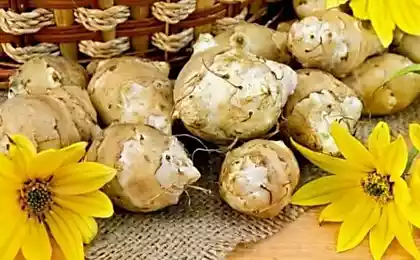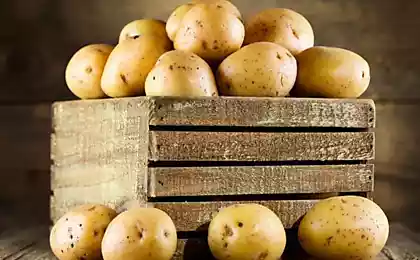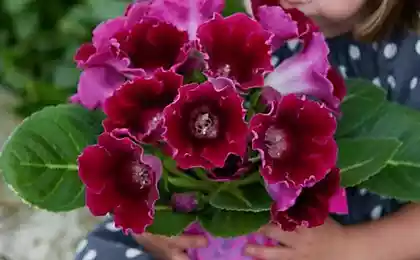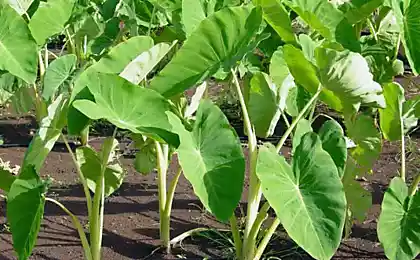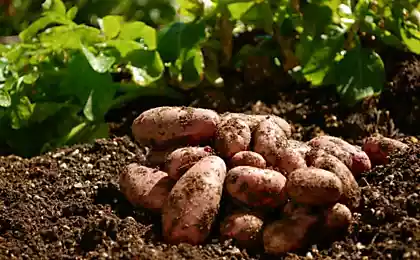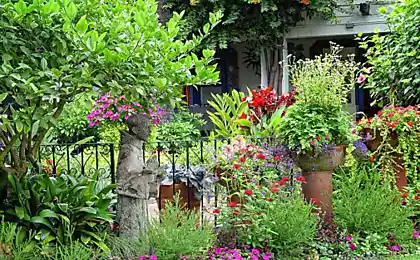447
Winter storage bulbotuberiferous – doing the right thing!
No matter how you love begonias and dahlias, freesias, and gladioli, not buy them, tubers and bulbs in an incredible amount. Don't forget that next season they will need more to keep.
Many novice gardeners in the fall I try to stock up more of the tubers without thinking, how to prepare bulbotuberiferous and conclusive culture to storage, and in the spring find that planting material is ruined.
To stop this from happening, we need, first, to assess their capabilities and desires: if you have no basement, garage or screened porch, that is any place in throughout the winter to maintain a temperature of 5-8°With, with the amount not worth chasing.
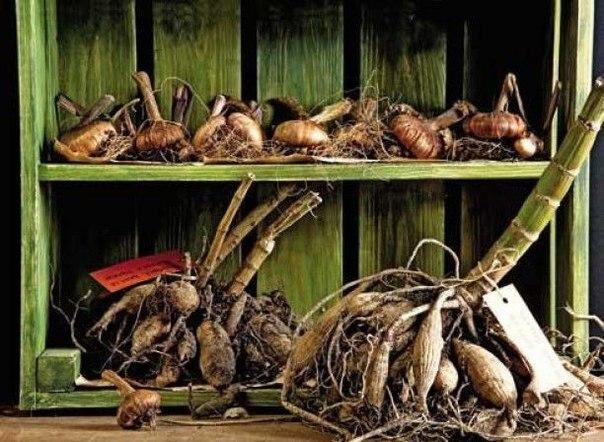
Second, make sure that the tubers and bulbs intended for storage, absolutely healthy and ripe. And third, when storing take into account the peculiarities of each culture.
During the winter all the inventory scan at least once a month. If you find signs of fungal diseases, rot, spot, and mold – affected area cleaned and treated with green paint or colloidal sulfur. Strongly affected tubers and bulbs immediately removed, so they do not become a source of infection.
How are preparing for winter and store tubers and bulbs of decorative flowering?
Montbretsiya, or crocosmia (Montbretia, Crocosmia)
This plant usually do so: at the end of September, the corms are dug, dried for several days at room temperature, separate the corms from klubnepochek. Stored at temperature of 5-7°C.
Fit another way: bushes to dig up entirely, the ground not shake, baby do not separate. Dried nests store in an open container. If the corms are large, you can take the risk and part of their leave to spend the winter in the soil, zamulchirovat a thick layer of peat (15 cm).
Tuberous begonia (Begonia x tuberhybrida)
The tuber of this plant must Mature in the middle band. To speed up the process, since mid-August, the begonias start to remove all the flowers. Dig the tubers before the morning frost.
The storage is often made so: stems cut to 2-3 cm, and the tubers dug up a shovel, clearing the roots from the soil, put them in boxes and transferred in a warm, well ventilated room. After about two weeks the remains of the stems removed, the tubers are cleaned from the soil and old roots and arrange for storage.
You can prepare the tubers in another way: the stems are cut, leaving a 5-10 cm long, the tubers are washed, treated with fungicide and lay out to dry. From the dried tubers of dried stems can be easily separated. Storage conditions –temperature 6-8°C, humidity 80-85%. Tubers it is better to pour peat or sawdust.
Dahlia (Dahlia)
Dahlias are dug, usually in late September and October, when the bushes turn black after the first frost. Before digging the stems cut at a height of 8-12 cm from the root collar. Removing korneklubni from the ground, try not to damage located at the root collar buds resume – without them, the tubers do not germinate.
Nest Dahlia washed from the soil, carefully inspected, cut out of severely damaged tubers, remove the fine feeding roots and immersed for 30 minutes in a solution of potassium permanganate. Before laying deposited within 7-10 days of them useful to hold at low positive temperatures. During this time there will be opracowanie the skin of the tuber, avoiding dry.
In storage, the tubers are placed on shelves or in drawers. A relative air humidity of 80%. In dry storage, the tubers dry out and shrivel. If the humidity is hard to ensure, the roots of dahlias placed in boxes and pour sand, peat or sawdust. To keep from drying them and using clay mash, lowering her tubers and dry until crisp.
Sometimes used waxing. Tubers share them out so that each had 1-3 buds resume. On the plate arrange a water bath in a suitable container melt the wax and for a moment one after the other immersed in his tubers. When the film hardens, the procedure is repeated until delenki is completely covered with paraffin. After that, they put in a hard container and put in storage.
A small amount of planting material can be saved until spring, wrapped in several layers of wet newsprint, then in Kraft paper and placing on bottom shelf of a refrigerator. From time to time the wet paper needs to be replaced.
Gladiolus (Gladiolus), Tigridia (Tigridia), atsidantera (Acidanthera)
These bulbotuberiferous preparing for winter the same way. At the beginning of October (if damp autumn early, since the end of September), the stem is cut, leaving 15-20 cm in length. Plants carefully removed from the earth, so that kids do not crumble: break forks and pull for the rest of the stem. You can then separate the baby.
Planting material is decomposed by species and size in pre-prepared containers. Under the young corm is preserved the old, shriveled corm, it is not separated, so as not to damage the bottom. Corms and baby is washed first in water, then in a solution of "Intevia" or "Sparks" and again in water, and then immersed in a solution of potassium permanganate. It is possible to use a preparation "Maxim".
After processing the tubers are laid on newsprint and dried. Within 5-7 days, maintain temperature of 25-30°C, providing good ventilation, and then be dried for one month at a temperature of 18-20°C. If the old corm separates easily, so the drying process can be considered complete. Dried remains of stems cut off with scissors. Covering scales are not removed.
Storage using cardboard boxes or boxes with lids. Their inner walls are treated with a spray type insecticide dichlorvos (you can use any designed for household purposes). The dried tubers are laid on grades in nylon bags and placed in boxes closed with lids and wrapped in newsprint, to the insecticide slowly evaporated. Optimum storage temperature is 1-5°C, relative humidity of about 80%.
A different approach and special storage conditions require freesia, anemone castellated, Ranunculus asiaticus.
Freesia (Freesia)
These tender plants are best grown in containers. They bloom in the fall. To the blooms lasted longer at the end of September container with flowers bring into the room. This simple solution will allow the corms to properly ripen (in the open air in the middle zone is unfeasible).
After the death of the aerial parts of the corms are dug, washed, disinfected and dried slightly. The recommended storage temperature is 26-30°C. Corms of freesia are small, they are very easy to overdry. Therefore it is best to put them in a sterile, tightly sealed cans and placed near radiators or pipes. There are other recommendations, but I must honestly admit that no method storage room does not guarantee the quality of flowering.
Crown anemone (Anemone coronaria), Asian Buttercup (Ranunculus asiaticus)
Thickened rhizomes of these plants after excavation are washed, treated in a fungicide solution and dried to a state of "crackers". Stored in any box or package at room temperature. Before planting the day soaked.published
P. S. And remember, only by changing their consumption — together we change the world! © Join us at Facebook , Vkontakte, Odnoklassniki
Source: vk.com/public55911986?w=wall-55911986_4178
Many novice gardeners in the fall I try to stock up more of the tubers without thinking, how to prepare bulbotuberiferous and conclusive culture to storage, and in the spring find that planting material is ruined.
To stop this from happening, we need, first, to assess their capabilities and desires: if you have no basement, garage or screened porch, that is any place in throughout the winter to maintain a temperature of 5-8°With, with the amount not worth chasing.

Second, make sure that the tubers and bulbs intended for storage, absolutely healthy and ripe. And third, when storing take into account the peculiarities of each culture.
During the winter all the inventory scan at least once a month. If you find signs of fungal diseases, rot, spot, and mold – affected area cleaned and treated with green paint or colloidal sulfur. Strongly affected tubers and bulbs immediately removed, so they do not become a source of infection.
How are preparing for winter and store tubers and bulbs of decorative flowering?
Montbretsiya, or crocosmia (Montbretia, Crocosmia)
This plant usually do so: at the end of September, the corms are dug, dried for several days at room temperature, separate the corms from klubnepochek. Stored at temperature of 5-7°C.
Fit another way: bushes to dig up entirely, the ground not shake, baby do not separate. Dried nests store in an open container. If the corms are large, you can take the risk and part of their leave to spend the winter in the soil, zamulchirovat a thick layer of peat (15 cm).
Tuberous begonia (Begonia x tuberhybrida)
The tuber of this plant must Mature in the middle band. To speed up the process, since mid-August, the begonias start to remove all the flowers. Dig the tubers before the morning frost.
The storage is often made so: stems cut to 2-3 cm, and the tubers dug up a shovel, clearing the roots from the soil, put them in boxes and transferred in a warm, well ventilated room. After about two weeks the remains of the stems removed, the tubers are cleaned from the soil and old roots and arrange for storage.
You can prepare the tubers in another way: the stems are cut, leaving a 5-10 cm long, the tubers are washed, treated with fungicide and lay out to dry. From the dried tubers of dried stems can be easily separated. Storage conditions –temperature 6-8°C, humidity 80-85%. Tubers it is better to pour peat or sawdust.
Dahlia (Dahlia)
Dahlias are dug, usually in late September and October, when the bushes turn black after the first frost. Before digging the stems cut at a height of 8-12 cm from the root collar. Removing korneklubni from the ground, try not to damage located at the root collar buds resume – without them, the tubers do not germinate.
Nest Dahlia washed from the soil, carefully inspected, cut out of severely damaged tubers, remove the fine feeding roots and immersed for 30 minutes in a solution of potassium permanganate. Before laying deposited within 7-10 days of them useful to hold at low positive temperatures. During this time there will be opracowanie the skin of the tuber, avoiding dry.
In storage, the tubers are placed on shelves or in drawers. A relative air humidity of 80%. In dry storage, the tubers dry out and shrivel. If the humidity is hard to ensure, the roots of dahlias placed in boxes and pour sand, peat or sawdust. To keep from drying them and using clay mash, lowering her tubers and dry until crisp.
Sometimes used waxing. Tubers share them out so that each had 1-3 buds resume. On the plate arrange a water bath in a suitable container melt the wax and for a moment one after the other immersed in his tubers. When the film hardens, the procedure is repeated until delenki is completely covered with paraffin. After that, they put in a hard container and put in storage.
A small amount of planting material can be saved until spring, wrapped in several layers of wet newsprint, then in Kraft paper and placing on bottom shelf of a refrigerator. From time to time the wet paper needs to be replaced.
Gladiolus (Gladiolus), Tigridia (Tigridia), atsidantera (Acidanthera)
These bulbotuberiferous preparing for winter the same way. At the beginning of October (if damp autumn early, since the end of September), the stem is cut, leaving 15-20 cm in length. Plants carefully removed from the earth, so that kids do not crumble: break forks and pull for the rest of the stem. You can then separate the baby.
Planting material is decomposed by species and size in pre-prepared containers. Under the young corm is preserved the old, shriveled corm, it is not separated, so as not to damage the bottom. Corms and baby is washed first in water, then in a solution of "Intevia" or "Sparks" and again in water, and then immersed in a solution of potassium permanganate. It is possible to use a preparation "Maxim".
After processing the tubers are laid on newsprint and dried. Within 5-7 days, maintain temperature of 25-30°C, providing good ventilation, and then be dried for one month at a temperature of 18-20°C. If the old corm separates easily, so the drying process can be considered complete. Dried remains of stems cut off with scissors. Covering scales are not removed.
Storage using cardboard boxes or boxes with lids. Their inner walls are treated with a spray type insecticide dichlorvos (you can use any designed for household purposes). The dried tubers are laid on grades in nylon bags and placed in boxes closed with lids and wrapped in newsprint, to the insecticide slowly evaporated. Optimum storage temperature is 1-5°C, relative humidity of about 80%.
A different approach and special storage conditions require freesia, anemone castellated, Ranunculus asiaticus.
Freesia (Freesia)
These tender plants are best grown in containers. They bloom in the fall. To the blooms lasted longer at the end of September container with flowers bring into the room. This simple solution will allow the corms to properly ripen (in the open air in the middle zone is unfeasible).
After the death of the aerial parts of the corms are dug, washed, disinfected and dried slightly. The recommended storage temperature is 26-30°C. Corms of freesia are small, they are very easy to overdry. Therefore it is best to put them in a sterile, tightly sealed cans and placed near radiators or pipes. There are other recommendations, but I must honestly admit that no method storage room does not guarantee the quality of flowering.
Crown anemone (Anemone coronaria), Asian Buttercup (Ranunculus asiaticus)
Thickened rhizomes of these plants after excavation are washed, treated in a fungicide solution and dried to a state of "crackers". Stored in any box or package at room temperature. Before planting the day soaked.published
P. S. And remember, only by changing their consumption — together we change the world! © Join us at Facebook , Vkontakte, Odnoklassniki
Source: vk.com/public55911986?w=wall-55911986_4178
The Chevrolet Volt was named the most "green" car of the year
Time-tested recipes from the sagging of the cheeks and not only


